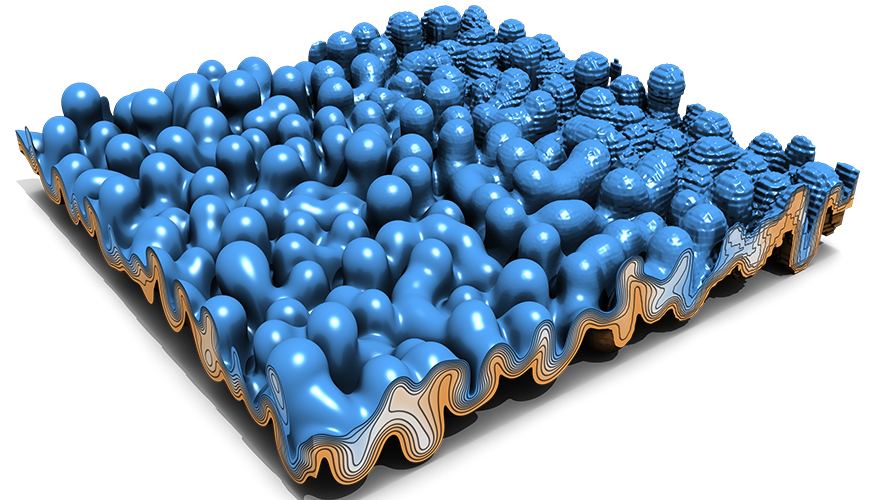LLNL’s Advanced Scientific Computing Research (ASCR) program conducts fundamental research in basic and applied mathematics, computer science, and data science.
Office of Science funding supports LLNL activities that advance state of the art high-performance computing to meet growing needs in artificial intelligence and machine learning as well as the Laboratory's national security mission. This work enables researchers to analyze, model, simulate, and predict complex phenomena and fuels emerging computing technologies and architectures, including quantum information systems.

Applied Mathematics
Parallel Multigrid in Time and Space for Extreme-Scale Computational Science
We are developing multigrid algorithms and techniques, focusing on parallel time integration methods, to address solver challenges anticipated in Department of Energy (DOE) science simulations on future architectures. Our parallel time integration methods have shown speed increases of more than 50 times. Breakthroughs in this area resulted in the first algorithmic approach for advection that is scalable for both explicit and implicit high-order schemes, with parallel speedups of 14 times demonstrated for the fifth-order scheme on 1024 cores.
Multilevel Methods, Numerical Upscaling, and Space-time Adaptive Mesh Refinement
We are developing scalable sampling strategies for multilevel Markov Chain Monte Carlo (MCMC) methods to accelerate large-scale applications. Our goal is to perform scalable MCMC sampling steps on each, using corresponding solvers with coarser mesh resolution. We have developed a new hierarchical approach to generalize realizations of spatially correlated random fields on complementary spaces.
High-Resolution Methods for Phase Space Problems in Complex Geometries
Mathematicians in the Center for Applied Scientific Computing (CASC) are developing and implementing high-order, conservative, and implicit finite volume methods in complex geometries, particularly targeting kinetic simulation of tokamak edge plasmas. A significant achievement of this work is the first-ever Eulerian simulations of ion temperature gradient (ITG) turbulence in single-null geometry, where the domain extends across the magnetic separatrix and into the edge plasma.
Simulation-Driven High-Order Mesh Adaptivity
In support of high-order finite element methods, we are advancing high-order mesh quality optimization and simulation-driven adaptivity. A significant contribution of this work is a new rigorous mathematical theory for high-order mesh quality based on the target-matrix optimization paradigm and variational optimization. This theory is the basis for purely geometrical and simulation driven mesh optimization algorithms in important DOE applications, such as high-order Arbitrary Lagrangian–Eulerian (ALE).
Multifaceted Mathematics for Rare, High-Impact Events in Complex Energy and Environment Systems (MACSER)
The Mathematical Multifaceted Integrated Capability Centers (MMICS) subprogram under MACSER is a project to create new multifaceted theoretical, applied, and computational mathematics. LLNL’s MACSER team addresses mathematical and computational challenges arising in the optimization of the U.S. electrical power grid. LLNL’s technical solution emerged as the most efficient computational approach in the Grid Optimization (GO) Competition organized by DOE’s Advanced Research Projects Agency–Energy (ARPA-E).
Computer Science
I/O Workload Characterization for Performance and Portability (IOPP)
LLNL researchers are working to deliver high-performance and productivity to I/O (input/output) workloads in high performance computing (HPC) by identifying, cataloging, and developing efficient support for HPC I/O behavior classes. We released a multilevel tracing tool, Recorder, that generates trace records for each layer in the I/O stack. Additionally, we created a publicly available dataset of I/O traces of 14 HPC applications that researchers can use to optimize I/O performance or design more efficient I/O libraries and file systems.
HPC-FAIR: A Framework Managing Data and AI Models for Analyzing and Optimizing Scientific Applications
We are developing a high-performance computing data management framework to make both training data and AI models of scientific applications findable, accessible, interoperable, and reusable (FAIR). We are: 1) collecting and generating representative training data and AI models; 2) developing program pattern analysis and translation tools for data from multiple sources; 3) designing an internal representation of training data and AI models; 4) providing easy access and user interfaces; and 5) automatically optimizing data processing function calls.
Partnerships
Frameworks, Algorithms, and Scalable Technologies for Mathematics (FASTMath) SciDAC Institute
The FASTMath SciDAC-5 Institute develops and deploys scalable mathematical algorithms and software tools for reliable simulation of complex physical phenomena. The institute collaborates with application scientists to ensure the usefulness and applicability of FASTMath technologies. FASTMath efforts have resulted in the creation of MFEM, an open-source scalable finite element discretization library; SUNDIALS, a suite of nonlinear and differential/algebriac equation solvers; and HYPRE, a library of scalable linear solvers and multigrid methods.
RAPIDS2: A SciDAC Institute for Computer Science, Data, and Artificial Intelligence
We are working to simplify the use of OpenMP for SciDAC applications and to deliver performance improvements to those applications through direct interactions, with a particular emphasis on the FastMath SUNDIALS library. LLNL's RAPIDS2 research will yield OpenMP extensions and tools that significantly ease performance optimization by automating directive selection and parameter settings when a variety of choices are available.
Center for Integrated Simulation of Fusion Relevant Radio-Frequency Actuators
LLNL is supporting a multi-institutional effort with the development of robust and accurate mathematical algorithms for discretization of anisotropic diffusion. We are also developing algorithms for Maxwell problems relevant to radio-frequency (RF) heating simulations in tokamak. We are collaborating with application partners in the RF-SciDAC center to implement these algorithms in new simulation tools and miniapps.
Plasma Surface Interactions: Predicting the Performance and Impact of Dynamic PFC (Plasma Facing Component) Surfaces
We are developing coupled models for the dynamic interaction between plasma and material surfaces at the edge of a magnetically confined fusion energy reactor, using our COGENT code to predict kinetic fluxes. We have implemented an edge localized mode (ELM) heat flux model to predict plasma fluxes on the tokamak divertor sheath. These predictions require the kinetic modeling of electrons and we have developed an efficient preconditioned semi-implicit algorithm to efficiently integrate the fast electron time scales.
Advanced Tokamak Modeling Environment (AToM)
We are developing an integrated capability for modeling of magnetic fusion reactors using high-performance computing by extending current simulation workflows, building essential infrastructure to address modeling gaps, and managing a large user base to provide a modeling capability that has broad community support. We have recently implemented a semi-implicit fluid model in COGENT for neutral species dynamics in the tokamak edge region and compared our simulations with those using UEDGE.
Integrated Simulation of Energetic Particles in Burning Plasmas
We are developing a multiscale and multiphysics framework for a predictive capability of energetic particle (EP) physics in fusion plasmas. We are also delivering software that incorporates both first-principles approaches and high-fidelity reduced transport models to the future whole device modeling (WDM) project.
Partnership Center for High-Fidelity Boundary Plasma Simulation
As part of a larger, multi-institutional project, LLNL researchers are developing rigorous, efficient and minimally intrusive verification methods for particle-in-cell schemes, particularly for fusion plasma modeling. A significant accomplishment was the development of a first-of-kind “particle-agnostic” verification scheme for particle-in-cell methods that is simpler and more rigorous than prior efforts.
Assessing and Improving the Numerical Solution of Atmospheric Physics in E3SM (Exascale Earth System Model)
We are working to achieve a better balance between cost and accuracy in time integration related to parameterizations in the E3SM atmosphere model (EAM). Our work involves identifying and introducing methods that reduce time integration errors in the subgrid parameterizations. We have identified sources of inconsistencies in splitting methods used in some models.
Tough Errors Are no Match (TEAM): Optimizing the Quantum Compiler for Noise Resilience
The TEAM project is developing a quantum compilation toolbox leveraging techniques from quantum characterization and control, probabilistic programming and approximate computing in a whole-of-team effort. The goal is to provide tools for unprecedented robustness, optimization and resilience in the quantum software stack. We will develop noise-resilient optimal control techniques for improved gate fidelities in current quantum devices.
Other
Sidney Fernbach Postdoctoral Fellowship in the Computing Sciences
This highly competitive postdoctoral position, established in 2012, is awarded to candidates with exceptional talent, scientific track records and potential for significant achievements in computational mathematics, computer science, data science, and/or scientific computing.

Jeffrey Hittinger
Lab Program Coordinator for ASCR at LLNL
hittinger1 [at] llnl.gov (hittinger1[at]llnl[dot]gov)




